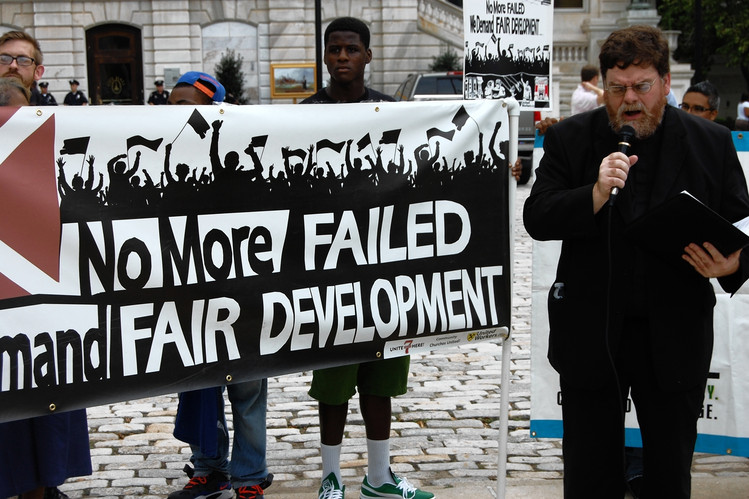
Progressives endlessly caricature free-market policies as “trickle-down” economics—giveaways to the undeserving rich with few benefits reaching the poor. In truth, trickle-down best characterizes the economic development policies pursued in deep-blue states like Maryland, where taxpayer dollars flow to the politically connected amid grandiose claims of “stimulative” effects.
A small but telling example is in Towson, a thriving suburb of Baltimore, where the proprietors of a sports-themed chain restaurant called the Greene Turtle recently built a rooftop bar so patrons could imbibe at altitude. Just good old American enterprise at work, except for the fact that, according to the Baltimore Sun, $505,000 of the $890,000 cost came out of taxpayers’ hides as low-interest government loans, much of which will be forgiven if the enterprise meets modest “employees added” targets and stays open five years.
When it comes to Keynesian-style stimulus at the state or local level, the juice is rarely worth the squeeze.
While local officials said the handouts were necessary to stimulate the Towson economy, the district’s state senator, James Brochin, correctly called it “corporate welfare,” and Maryland Comptroller Peter Franchot (alone among the members of the state’s Board of Public Works) voted against the appropriation.
But the checks were cut, and at the grand opening on Jan. 2. Maryland’s First Lady, Katie O’Malley, presented a governor’s citation to the bar’s proprietors, who happened to be childhood friends. It’s remarkable how often development dollars trickle first to cronies or political donors.
When it comes to Keynesian-style stimulus at the state or local level, however, the juice is rarely worth the squeeze. The alleged magic of the multiplier—by which extra dollars of government spending supposedly ripple through the economy and raise incomes by several times that amount—depends on spending that is financed by deficits. But Maryland and most other state and local governments must balance their budgets, and the higher taxes required to finance these development programs crowd out private spending and offset some or all of the hoped-for stimulus.
These schemes also damage growth by misallocating capital. In markets, only projects that promise a return in excess of the cost of borrowing get built. Government allocation of capital, by contrast, exalts the judgments of politicians and bureaucrats over those of consumers and investors, and substitutes political pull for economic merit in the competition for capital. In combination, this is a prescription for inefficiency, inequity and corruption.
Maryland supplies examples of all three. In 2006, Martin O’Malley —then Baltimore’s mayor, now the state’s governor and a presidential aspirant—decided that the Baltimore Convention Center needed an adjoining hotel. Private investors disagreed, so City Hall “invested” $300 million to enter the hospitality industry. Since opening its doors in August 2008, the Hilton Baltimore—city-owned but managed by the global hotelier—has recorded more than $50 million in operating losses.
Baltimore’s relentless and much-applauded campaign of subsidized development along its waterfront provides another example. Tax breaks of more than $200 million for a $1 billion project on a former industrial site called Harbor Point—justified with the usual claims that this will create thousands of jobs—have provoked demonstrations by citizens who now realize that these promises are empty. Since 2001, the city has bled 49,000 jobs.
Last summer, attired in “Tax Dodgers” baseball uniforms, members of the United Workers and Unite Here, community activist groups, staged a public protest against Harbor Point, a mixed-use business and residence project. “Time and again,” the United Workers complained on its website, “the city has awarded our resources to wealthy developers at the taxpayers’ expense in the hope that money will trickle down. This model has failed.”
Then there is the $1.5 billion “partnership” among the state, city and developers of Baltimore’s State Center district, which will build new “eco-friendly” government offices to replace acres of Soviet-style buildings from the 1950s, ’60s and ’70s. Though not yet: Baltimore Circuit Judge Althea M. Handy ruled last year that the deals negotiated in 2007-09 with several connected firms—which did not involve competitive bidding and guaranteed that tenants would pay above-market rents—violated state procurement laws. He voided the contracts, and an appeal is pending.
Officials hail every such project as a “game-changer,” but each poaches business from older areas. For every subsidized “partner” of government, there is an unsubsidized loser. Thus, Baltimore’s trickle-down policies increasingly meet opposition not just from populist community organizers, but from out-of-favor investors. The “Coalition to Save Downtown Baltimore,” made up of landlords, small retailers and the Little Italy Restaurant Association, argues that two-million square feet of vacant space is available downtown and that “It makes no sense to squander over $1.5 billion taxpayer dollars on this ill-advised project.”
In this policy regime, connections are everything, and politicians can demand tribute from all directions—though not without risk. In separate scandals involving allegations of influence-buying by developers (one of whom was initially involved in State Center), Sheila Dixon, Mr. O’Malley’s successor as mayor, resigned in disgrace and councilwoman Helen Holton was censured and fined.
So how are Maryland’s adventures in capital misallocation working out? To fund spending on everything from offshore wind farms to roof bars, Gov. O’Malley has raised taxes and fees more than two-dozen times, on personal and corporate incomes and on retail sales, gas, tobacco, alcohol and much else. Yet the state still faces “structural” deficits estimated at $166 million for the next two fiscal years.
Meanwhile, the nonpartisan Tax Foundation reports that a net of 66,000 residents and $5.5 billion in taxable income fled Maryland in 2000-10—a “Free State” trend that shows no signs of abating.
Author Steve H. Hanke

0 responses on "Progressive Trickle-Down in Maryland"